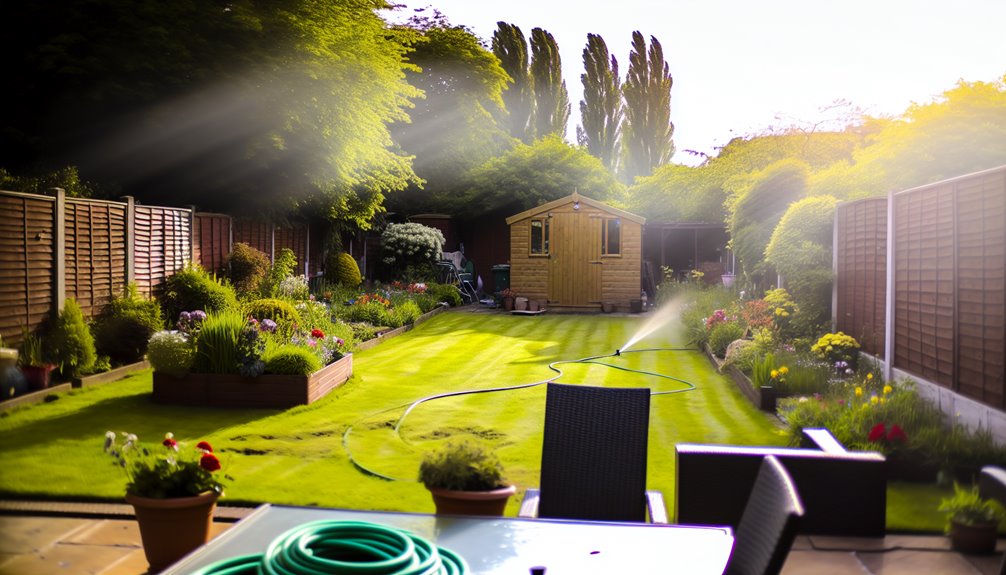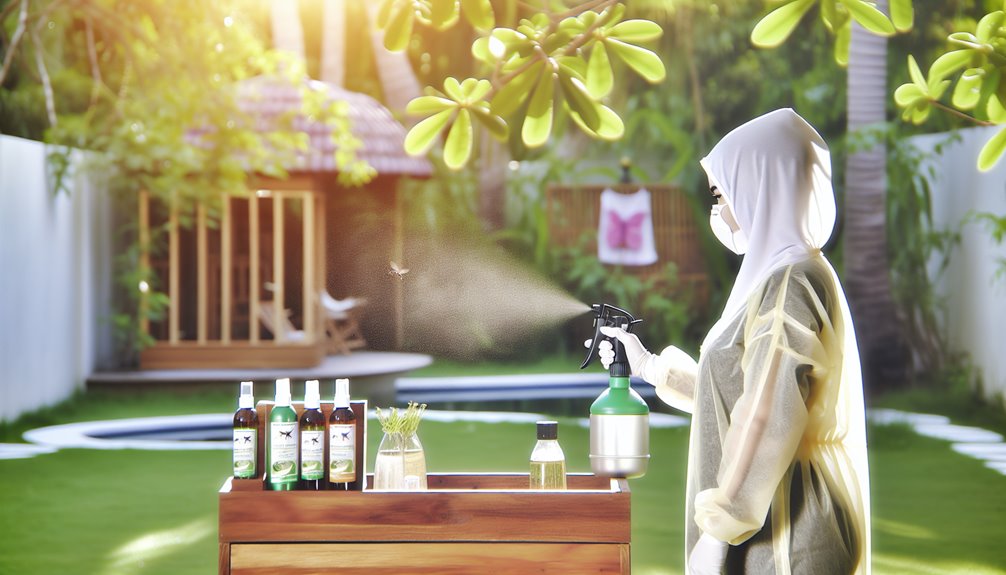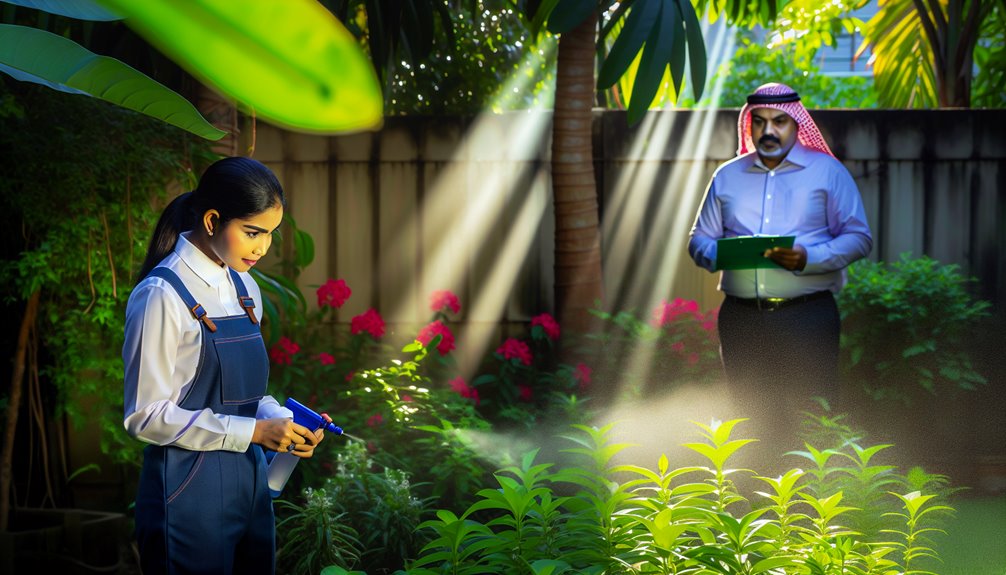Up to 80% of mosquito species can breed in a bottle-cap of water, which is why your first treatment focuses on precise source reduction and targeted applications. You’ll prepare the yard for access, then technicians inspect vegetation, shaded zones, and water-holding items, applying larvicides and residual adulticides per label. They’ll follow strict reentry times for kids and pets and note weather constraints. You’ll learn when results appear, what to monitor, and the next steps—starting with a quick yard check.
Preparing Your Yard Before the Appointment

Before your technician arrives, verify the yard is accessible, dry, and clear of hazards. Open gates, restrain pets indoors, and schedule irrigation to end at least 24 hours prior. Remove toys, tools, and tarps to expose surfaces. Empty standing water from buckets, birdbaths, planters, and gutters to support yard maintenance and pest prevention. Mow turf to recommended height; trim dense vegetation for safe, even coverage. Store food, pet bowls, and grills. Close windows, cover fish ponds, and relocate outdoor fabrics. Mark fragile plants. Identify electrical hazards and note recent treatments. Keep children inside during service and until the reentry interval elapses.
What Areas Technicians Target and Why
Technicians focus on three mosquito hot zones: resting sites, breeding sources, and flight paths. They inspect dense vegetation, undersides of leaves, and shaded structures where adults rest. They assess standing water, clogged gutters, planters, toys, and tarps—common breeding habitats—then map target zones to interrupt life cycles. They trace flight paths from shade to you, prioritizing entryways, patios, and walkways. You’ll receive guidance to remove water reservoirs and trim foliage, increasing safety and effectiveness. Technicians verify access, note wind and drift, and protect pollinator areas. Their systematic sequence—inspect, prioritize, treat, and recheck—maximizes control while minimizing exposure and off-target impact.
Products Used: Types, Methods, and How They Work

While site conditions drive selection, you’ll typically see three product classes: adulticides, larvicides, and growth regulators. Adulticides knock down flying adults via ULV misting or residual barrier sprays on shaded vegetation. Larvicides target water, interrupting development with bacterial toxins or insect growth inhibitors. Growth regulators prevent emergence by disrupting molting.
Technicians may supplement with mosquito repellents for short-term comfort but prioritize source reduction and precise applications. They’ll calibrate equipment, verify label rates, and document treatment frequencies based on pressure and weather. You’ll support outcomes by maintaining drainage and rejuvenating water features. Expect measurable reductions within days, with maintenance visits sustaining control.
Safety Protocols for Kids, Pets, and Pollinators
A few core protocols keep families, pets, and pollinators safe during mosquito control. You’ll secure child safety by keeping kids indoors, away from treated areas, until sprays dry fully per label—typically 30–60 minutes. For pet precautions, crate animals or confine them inside; remove bowls, toys, and bedding; return them only after surfaces dry. Cover or move aquariums and turn off air pumps temporarily. Protect pollinators by requesting dusk or dawn applications, avoiding blooms, and targeting shaded resting sites, not flowers. Close windows, extinguish outdoor flames, and store laundry, cushions, and produce. After treatment, ventilate briefly and rinse food-contact surfaces.
The Treatment Process Step by Step

Before any product is applied, you’ll confirm site readiness and the treatment plan: verify weather (no rain or strong wind forecast for 24 hours), identify mosquito hotspots (shaded foliage, under decks, dense shrubs), and note sensitive areas (edible gardens, koi ponds, beehives). Next, brief the household on access, gates, and pets. Clarify treatment expectations and establish technician communication preferences.
Conduct a perimeter walk-through, eliminate standing water, and stage equipment. Calibrate the backpack mister, select label-appropriate mix, and don PPE. Apply from exterior inward, targeting underside foliage and shaded harborage, avoiding drift toward sensitive zones. Flag treated areas, document products, and review post-care instructions.
Timing: How Long Service Takes and When You’ll See Results
Once the site is prepped and equipment is staged, a standard residential treatment typically takes 30–60 minutes, depending on lot size, vegetation density, and access. You’ll see adult knockdown within hours and a clearer result timeline by day 2–3 as residues settle and larvae are disrupted. Full effectiveness stabilizes by week one.
- Timing factors: square footage, clutter, slope, and canopy height affect coverage pace.
- Secure pets and people indoors until surfaces dry (usually 30–45 minutes).
- Keep irrigation off for 24 hours to protect residual.
- Expect maintenance visits every 21–30 days to sustain suppression and serve your household well.
Weather Considerations and Rescheduling Policies
If rain, high wind, or extreme heat move in, you and your technician should reassess the treatment window to protect efficacy and safety. Weather impact matters: wind can cause drift, rain can wash off residues, and heat can volatilize products. Verify local forecasts two to four hours before arrival. If conditions exceed label limits, pause operations. Document site status, product selected, and thresholds reached. Apply only when surfaces are dry, wind is below 10 mph, and temperatures fall within label range. Follow your provider’s rescheduling policies: confirm next openings, prioritize vulnerable areas, and coordinate access. Communicate promptly to serve your household well.
Aftercare, Follow-Up Visits, and How Long Protection Lasts
Although a well-executed treatment knocks down adult mosquitoes quickly, you should manage the site to preserve residues and monitor results. Prioritize aftercare tips that keep people and pets safe while sustaining control. Expect residual protection for 3–4 weeks, depending on rainfall, shade, and vegetation density. Plan follow up frequency at 21–30 days, sooner after heavy storms. Document bite activity, larval habitats, and resting sites to guide adjustments.
- Stay off treated foliage until dry; ventilate patios.
- Eliminate standing water; refresh birdbaths every 2–3 days.
- Mow and trim to reduce shaded harborage.
- Log observations; share photos before follow-up.
Conclusion
As the owner of Mosquito Eliminators of South MS, I want you to feel confident and excited about your journey towards a mosquito-free yard. We’ve covered a lot today, and I hope you’re feeling empowered and ready to take the next steps. If you have any questions or would like to learn more about our services, I warmly invite you to visit our website at mosquitoeliminatorsms.com or give us a call at (601) 336-2277. Together, we can create a safe and enjoyable outdoor space for you and your loved ones. Let’s make those evening gatherings free from buzzing nuisances, and look forward to many peaceful nights in your backyard!

